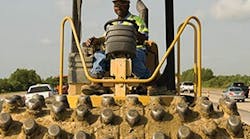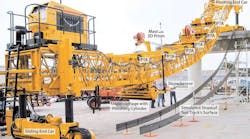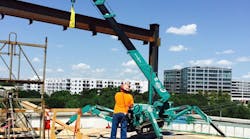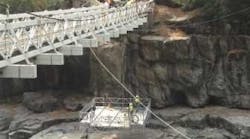The biggest challenges in airport runway projects often don't lie within the sheer amount of dirt that must be moved and graded, but in the tight tolerances mandated by the Federal Aviation Administration (FAA)
In Cedar Rapids, IA, as it worked on the taxiway portion of a multiyear runway project for Eastern Iowa Airport, the general contractor — Cedar Valley Corp. — recently discovered that the best tool available to help meet those tight tolerances was the precise positioning made possible through its grading subcontractor's GPS machine controls.
The Eastern Iowa Airport project in its entirety includes rebuilding the main runway and a parallel taxiway, as well as replacing multiple intersections between the main and secondary runways. FAA tolerances require grades within the project to fall between 0 and +/- 0.03 feet. These tolerances are critical for producing a smooth, uniform surface for aircraft and providing proper drainage of storm water.
DeLong Construction, based in Washington, IA, was subcontractor for the rough grading for the Eastern Iowa Airport project. When applied as a surveying tool, GPS — or the global positioning system — can be used to accurately measure the geographic area, and allows the technician to more easily employ a three-dimensional model of the finished project with the desired grade. As a machine control, it then guides the bulldozer or grader's blade to accurately produce the modeled grade.
According to Paul Ruckman, GPS technician for DeLong Construction, the company's work involved two phases. "Our first step was to remove the old taxiway, stockpile and recycle the concrete material," he says. "We then were to do the rough grading, prepare the subgrade and place the recycled aggregate back down for the general contractor to use as base for the paving."
The taxiway project — running 3,400 linear feet, consisting of 71,000 cubic yards of unclassified excavation, 25,200 cubic yards of topsoil, and including 68,000 square yards of granular surfacing — encountered challenges as soon as the old concrete as removed. In June 2008, eastern Iowa was inundated with flooding of historic proportions that also affected the Cedar Rapids airport.
Not only were there days when DeLong Construction's employees had to travel two hours out of their way to reach the site due to road closures, but the sticky mud on site hindered stabilization efforts. "We had to add fly ash to the dirt to help it stiffen up," says Ruckman. "And at one point, the mud was so thick that we had to get a bulldozer to pull the tiller through the grade. It was crazy."
But in the end, it was the GPS machine controls that saved the day not only for DeLong Construction, but also for Cedar Valley Corp. First, DeLong Construction created the subgrade to the FAA-mandated tolerances of +/- 0.04 feet, and the engineering firm — Foth/Engineering Alliance Inc. — sent out its surveyor to check the subgrade in a 25-foot grid. DeLong Construction then placed the recycled aggregate on the subgrade as unbound subbase, and graded the rock to be 1/10 above grade so that the trimmer could cut the grade to tighter FAA tolerances of +/- 0.03 feet.
"After that, the pavers realized they couldn't trim some of the areas to the tolerances expected," says Ruckman. "They had trouble keeping the grade in spec. The pavement also has to remain within the FAA tolerances of +/- 0.03 feet. So, that's when they asked us to come back out and grade behind them to fix the errors."
Ruckman says, "There are a lot of variables involved to get tolerances like this out of the GPS system. Most people say that it's only good to one-tenth of a foot. I say it is as good as the people operating it, from the design side to the machine side."
"Without the GPS, it couldn't have been done," says Deran DeLong, general manager of DeLong Construction. "With the old way of grading, with string lines, we would have had to trim the dirt a second time on the subgrade. We were able to avoid that using the GPS. And with this particular project, we wouldn't have been able to touch up behind the pavers like we did without the GPS machine controls, either."
For its GPS controls, DeLong Construction uses the HiPer Lite 3D-MC system by Topcon Positioning Systems. This system allows automatic, stakeless grading as it communicates with satellites to accurately measure distance and elevation, so that it can control the cut and fill requirements.
"With the Topcon GPS systems, we start with a two-dimensional drawing," says Ruckman. "Using AutoCAD (three-dimensional modeling software), we import it and turn it into a 3-D model. Then we go into the field and do our localization. This places the drawing in the right location in the field. We then export it to the automated machine, which builds the grade based on the 3-D drawing."
Founded in 1994 by Dana DeLong-Patterson and Deran DeLong, DeLong Construction's initial expertise was in simple earthmoving. Since that time, the company has grown to 70 employees and offers heavy highway earthmoving, underground utility installation, site development, mine reclamation, concrete crushing, and demolition throughout Iowa.
Deran DeLong explains that when DeLong Construction installed its first GPS machine control system, he noticed the company was one of the first in the area to provide that capability. "It's coming around, though," he says. "I see more and more contractors are realizing the benefits."
DeLong adds that the company's GPS equipment dealer, Des Moines, IA-based Star Equipment, has been a great asset to DeLong Construction, as it has added GPS machine control capability to its machines.




